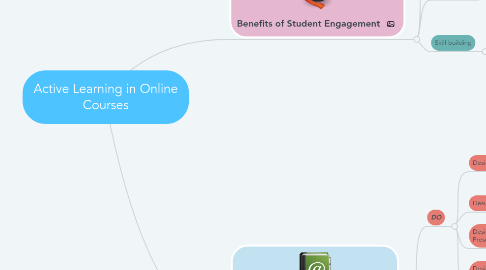
1. Benefits of Student Engagement
1.1. Learner Centered Instruction
1.2. Critical Thinking
1.2.1. Analytical Skills
1.2.2. Evaluation Skills
1.3. Metacognition
1.4. Skill-building
1.4.1. Discussion and Debate Skills
1.4.2. Argumentative Skills
1.4.3. Technology Skills
1.4.4. Human Connections
2. Do's and Don'ts of Student Engagement in Online Courses
2.1. DO
2.1.1. Design Meaningful Assignments
2.1.1.1. This helps prevent student discouragement as students see meaningful assignments as part of their learning and movement toward a goal.
2.1.2. Design Assignments that Build Skill
2.1.2.1. This helps student see a positive outcome and can promote satisfaction with the course.
2.1.3. Design Assignments that Promote Social Presence
2.1.3.1. Social Presence has been linked with greater success and course satisfaction.
2.1.4. Design Assignments that Help Students Master Content
2.1.4.1. Mastering content helps students be successful in the course and their degree program; it also fulfills one of their main goals for entry in to the course.
2.2. DONTS
2.2.1. Design Assignments That Are Just Busy Work
2.2.1.1. Students often resent these assignments and become discouraged. They also decrease student satisfaction with courses.
2.2.2. Design Assignments That Promote Little Skill Building
2.2.2.1. Same as above, but these are also useless and wastes of time.
2.2.3. Take Precautions in the Use of Social Media Based Assignments that Require Interaction
2.2.3.1. Can be harmful; be aware of how social media and communication tools can be abused.
2.2.4. Design Assignments NOT Linked to Learning Outcomes
2.2.4.1. Cohesion and relevancy are important to students. Mapping curriculum is just as important in online courses as face-to-face.
